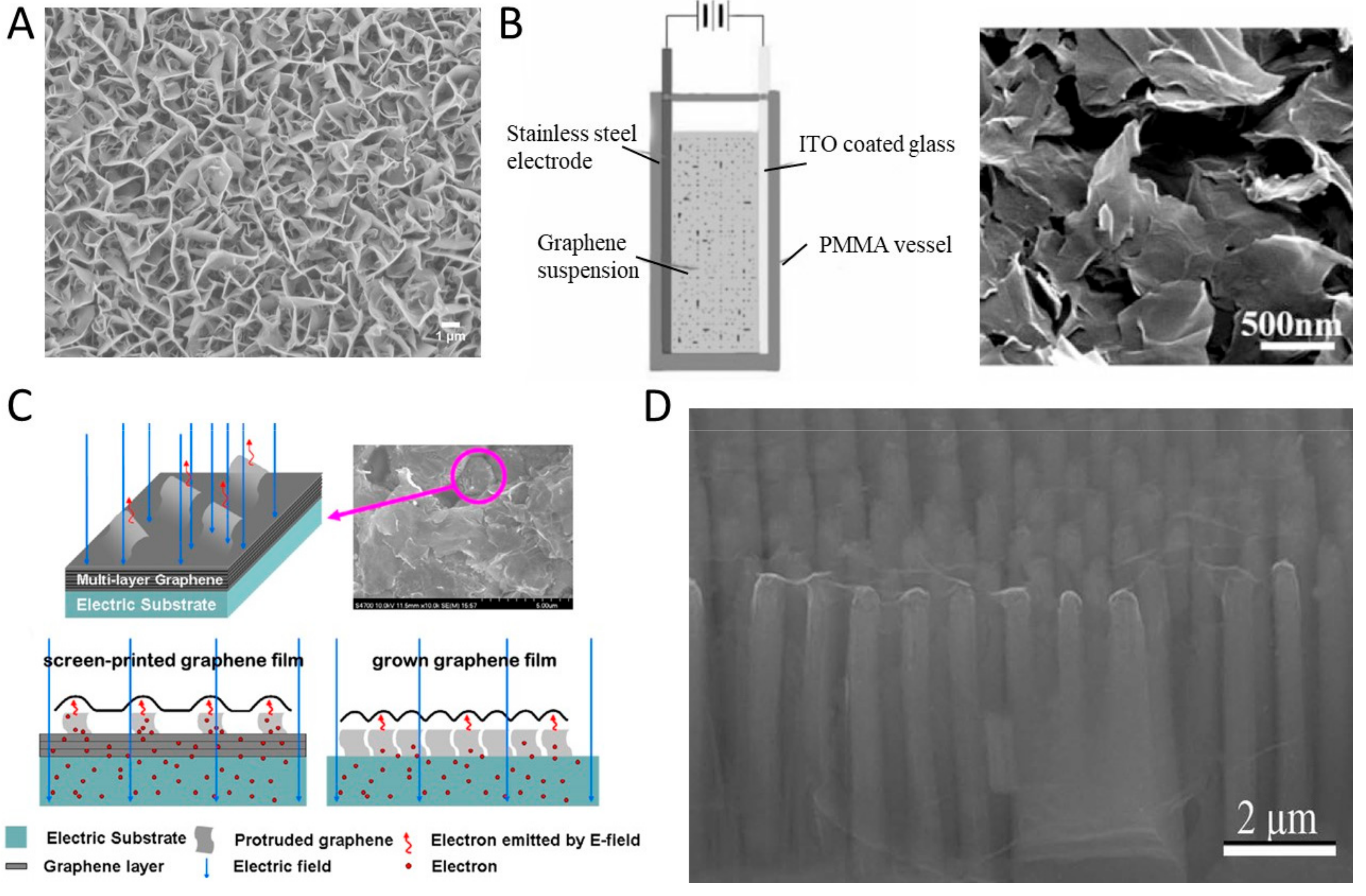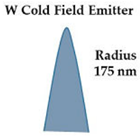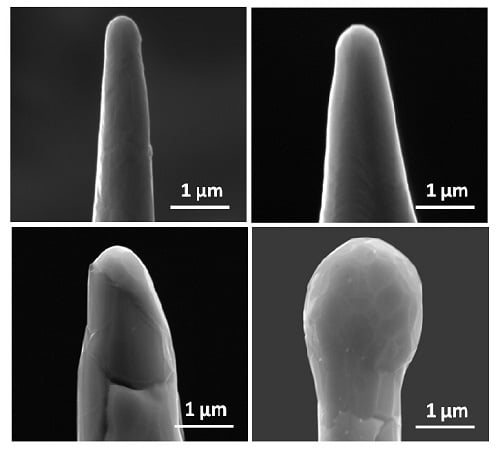A Review Paper on “Graphene Field Emission for Electron Microscopy”
Abstract
1. Introduction
2. Development of a Single-Tip Cathode Cold Field Emission Source
2.1. Theory of Cold Field Electron Emission
2.2. Source Electron Optics Parameters
2.3. The State-Of-The-Art Electron Source Used in Electron Microscopes
2.4. Nanoscale Point-Cathode Emitters
3. Graphene-Based Cold Field Emitters
3.1. Graphene Film Emitters
3.2. Graphene Point-Cathode Field Emitters
3.3. Graphene Ring-Cathode Field Emitters
4. Conclusions
Funding
Acknowledgments
Conflicts of Interest
References
- Dyke, W.; Dolan, W. Field emission. Adv. Electron. Electron Phys. 1956, 8, 89–185. [Google Scholar]
- Crewe, A.; Wall, J.; Welter, L. A high-resolution scanning transmission electron microscope. J. Appl. Phys. 1968, 39, 5861–5868. [Google Scholar] [CrossRef]
- Crewe, A.V.; Isaacson, M.; Johnson, D. A simple scanning electron microscope. Rev. Sci. Instrum. 1969, 40, 241–246. [Google Scholar] [CrossRef]
- Swanson, L.; Schwind, G. A review of the cold-field electron cathode. Adv. Imaging Electron Phys. 2009, 159, 63–100. [Google Scholar]
- Schwind, G.; Magera, G.; Swanson, L. Comparison of parameters for Schottky and cold field emission sources. J. Vac. Sci. Technol. B 2006, 24, 2897–2901. [Google Scholar] [CrossRef]
- Tuggle, D.; Swanson, L. Emission characteristics of the ZrO/W thermal field electron source. J. Vac. Sci. Technol. B 1985, 3, 220–223. [Google Scholar] [CrossRef]
- Fransen, M.; Overwijk, M.; Kruit, P. Brightness measurements of a ZrO/W Schottky electron emitter in a transmission electron microscope. Appl. Surf. Sci. 1999, 146, 357–362. [Google Scholar] [CrossRef]
- Tuggle, D.; Swanson, L.; Orloff, J. Application of a thermal field emission source for high resolution, high current e-beam microprobes. J. Vac. Sci. Technol. 1979, 16, 1699–1703. [Google Scholar] [CrossRef]
- Crewe, A.; Eggenberger, D.; Wall, J.; Welter, L. Electron gun using a field emission source. Rev. Sci. Instrum. 1968, 39, 576–583. [Google Scholar] [CrossRef]
- De Jonge, N.; Van Druten, N. Field emission from individual multiwalled carbon nanotubes prepared in an electron microscope. Ultramicroscopy 2003, 95, 85–91. [Google Scholar] [CrossRef]
- Bonard, J.-M.; Dean, K.A.; Coll, B.F.; Klinke, C. Field emission of individual carbon nanotubes in the scanning electron microscope. Phys. Rev. Lett. 2002, 89, 197602. [Google Scholar] [CrossRef] [PubMed]
- Fransen, M.; Van Rooy, T.L.; Kruit, P. Field emission energy distributions from individual multiwalled carbon nanotubes. Appl. Surf. Sci. 1999, 146, 312–327. [Google Scholar] [CrossRef]
- De Jonge, N.; Lamy, Y.; Schoots, K.; Oosterkamp, T.H. High brightness electron beam from a multi-walled carbon nanotube. Nature 2002, 420, 393. [Google Scholar] [CrossRef] [PubMed]
- Houdellier, F.; De Knoop, L.; Gatel, C.; Masseboeuf, A.; Mamishin, S.; Taniguchi, Y.; Delmas, M.; Monthioux, M.; Hÿtch, M.; Snoeck, E. Development of TEM and SEM high brightness electron guns using cold-field emission from a carbon nanotip. Ultramicroscopy 2015, 151, 107–115. [Google Scholar] [CrossRef] [PubMed]
- Yeong, K.; Thong, J. Field-emission properties of ultrathin 5 nm tungsten nanowire. J. Appl. Phys. 2006, 100, 114325. [Google Scholar] [CrossRef]
- Zhang, H.; Tang, J.; Yuan, J.; Yamauchi, Y.; Suzuki, T.T.; Shinya, N.; Nakajima, K.; Qin, L.-C. An ultrabright and monochromatic electron point source made of a LaB6 nanowire. Nat. Nanotechnol. 2016, 11, 273. [Google Scholar] [CrossRef] [PubMed]
- Novoselov, K.S.; Geim, A.K.; Morozov, S.; Jiang, D.; Katsnelson, M.; Grigorieva, I.; Dubonos, S.; Firsov, A.A. Two-dimensional gas of massless Dirac fermions in graphene. Nature 2005, 438, 197–200. [Google Scholar] [CrossRef] [PubMed]
- Xiao, Z.; She, J.; Deng, S.; Tang, Z.; Li, Z.; Lu, J.; Xu, N. Field electron emission characteristics and physical mechanism of individual single-layer graphene. ACS Nano 2010, 4, 6332–6336. [Google Scholar] [CrossRef] [PubMed]
- Lei, W.; Li, C.; Cole, M.T.; Qu, K.; Ding, S.; Zhang, Y.; Warner, J.H.; Zhang, X.; Wang, B.; Milne, W.I. A graphene-based large area surface-conduction electron emission display. Carbon 2013, 56, 255–263. [Google Scholar] [CrossRef]
- Geim, A.K.; Novoselov, K.S. The rise of graphene. Nat. Mater. 2007, 6, 183–191. [Google Scholar] [CrossRef] [PubMed]
- Balandin, A.A.; Ghosh, S.; Bao, W.; Calizo, I.; Teweldebrhan, D.; Miao, F.; Lau, C.N. Superior thermal conductivity of single-layer graphene. Nano Lett. 2008, 8, 902–907. [Google Scholar] [CrossRef] [PubMed]
- Neto, A.C.; Guinea, F.; Peres, N.M.; Novoselov, K.S.; Geim, A.K. The electronic properties of graphene. Rev. Mod. Phys. 2009, 81, 109. [Google Scholar] [CrossRef]
- Lee, C.; Wei, X.; Kysar, J.W.; Hone, J. Measurement of the elastic properties and intrinsic strength of monolayer graphene. Science 2008, 321, 385–388. [Google Scholar] [CrossRef] [PubMed]
- Ye, D.; Moussa, S.; Ferguson, J.D.; Baski, A.A.; El-Shall, M.S. Highly efficient electron field emission from graphene oxide sheets supported by nickel nanotip arrays. Nano Lett. 2012, 12, 1265–1268. [Google Scholar] [CrossRef] [PubMed]
- Lv, S.; Li, Z.; Liao, J.; Wang, G.; Li, M.; Miao, W. Optimizing field emission properties of the hybrid structures of graphene stretched on patterned and size-controllable SiNWs. Sci. Rep. 2015, 5, 15035. [Google Scholar] [CrossRef] [PubMed]
- Zhang, Y.; Du, J.; Tang, S.; Liu, P.; Deng, S.; Chen, J.; Xu, N. Optimize the field emission character of a vertical few-layer graphene sheet by manipulating the morphology. Nanotechnology 2011, 23, 015202. [Google Scholar] [CrossRef] [PubMed]
- Hernandez-Garcia, C.; O Shea, P.G.; Stutzman, M.L. Electron sources for accelerators. Phys. Today 2008, 61, 44–49. [Google Scholar] [CrossRef]
- Choi, W.; Chung, D.; Kang, J.; Kim, H.; Jin, Y.; Han, I.; Lee, Y.; Jung, J.; Lee, N.; Park, G. Fully sealed, high-brightness carbon-nanotube field-emission display. Appl. Phys. Lett. 1999, 75, 3129–3131. [Google Scholar] [CrossRef]
- Saito, Y.; Uemura, S. Field emission from carbon nanotubes and its application to electron sources. Carbon 2000, 38, 169–182. [Google Scholar] [CrossRef]
- Barber, M.; Bordoli, R.; Sedgwick, R.; Tyler, A. Fast atom bombardment of solids as an ion source in mass spectrometry. Nature 1981, 293, 270–275. [Google Scholar] [CrossRef]
- Khursheed, A. Scanning Electron Microscope. U.S. Patent 7,294,834, 2007. [Google Scholar]
- Khursheed, A. Scanning Electron Microscope Optics and Spectrometers; World Scientific: Singapore, 2011. [Google Scholar]
- Murphy, E.L.; Good, R., Jr. Thermionic emission, field emission, and the transition region. Phys. Rev. 1956, 102, 1464. [Google Scholar] [CrossRef]
- Fowler, R.H.; Nordheim, L. Electron emission in intense electric fields. Proc. R. Soc. Lond. A 1928, 119, 173–181. [Google Scholar] [CrossRef]
- Bronsgeest, M.; Barth, J.; Swanson, L.; Kruit, P. Probe current, probe size, and the practical brightness for probe forming systems. J. Vac. Sci. Technol. B 2008, 26, 949–955. [Google Scholar] [CrossRef]
- Kruit, P.; Jansen, G.H. Space charge and statistical coulomb effects. In Handbook of Charged Particle Optics, 2nd ed.; Taylor & Francis: Abingdon, UK, 1997. [Google Scholar]
- Cook, B.; Verduin, T.; Hagen, C.; Kruit, P. Brightness limitations of cold field emitters caused by Coulomb interactions. J. Vac. Sci. Technol. B 2010, 28. [Google Scholar] [CrossRef]
- Kratschmer, E.; Rishton, S.; Kern, D.; Chang, T. Quantitative analysis of resolution and stability in nanometer electron beam lithography. J. Vac. Sci. Technol. B 1988, 6, 2074–2079. [Google Scholar] [CrossRef]
- Rishton, S.; Beaumont, S.; Wilkinson, C. Measurement of the profile of finely focused electron beams in a scanning electron microscope. J. Phys. E Sci. Instrum. 1984, 17, 296. [Google Scholar] [CrossRef]
- Fransen, M.; Damen, E.; Schiller, C.; van Rooy, T.; Groen, H.; Kruit, P. Characterization of ultrasharp field emitters by projection microscopy. Appl. Surf. Sci. 1996, 94, 107–112. [Google Scholar] [CrossRef]
- Young, R.D. Theoretical total-energy distribution of field-emitted electrons. Phys. Rev. 1959, 113, 110. [Google Scholar] [CrossRef]
- Knauer, W. Energy broadening in field emitted electron and ion-beams. Optik 1981, 59, 335–354. [Google Scholar]
- Krivanek, O.; Corbin, G.; Dellby, N.; Elston, B.; Keyse, R.; Murfitt, M.; Own, C.; Szilagyi, Z.; Woodruff, J. An electron microscope for the aberration-corrected era. Ultramicroscopy 2008, 108, 179–195. [Google Scholar] [CrossRef] [PubMed]
- Jeol USA Press Releases. Available online: http://www.webcitation.org/6zUwGhedE (accessed on 18 May 2018).
- Dyke, W.; Charbonnier, F.; Strayer, R.; Floyd, R.; Barbour, J.; Trolan, J. Electrical stability and life of the heated field emission cathode. J. Appl. Phys. 1960, 31, 790–805. [Google Scholar] [CrossRef]
- Knápek, A.; Grmela, L.; Šikula, J.; Šik, O. Cold field-emission cathode noise analysis. Metrol. Meas. Syst. 2012, 19, 417–422. [Google Scholar] [CrossRef]
- Ajayan, P. Nanotubes from carbon. Chem. Rev. 1999, 99, 1787–1800. [Google Scholar] [CrossRef] [PubMed]
- Berber, S.; Kwon, Y.-K.; Tománek, D. Unusually high thermal conductivity of carbon nanotubes. Phys. Rev. Lett. 2000, 84, 4613. [Google Scholar] [CrossRef] [PubMed]
- Ebbesen, T.; Lezec, H.; Hiura, H.; Bennett, J.; Ghaemi, H.; Thio, T. Electrical conductivity of individual carbon nanotubes. Nature 1996, 382, 54–56. [Google Scholar] [CrossRef]
- Zhang, H.; Tang, J.; Zhang, Q.; Zhao, G.; Yang, G.; Zhang, J.; Zhou, O.; Qin, L.C. Field emission of electrons from single LaB6 nanowires. Adv. Mater. 2006, 18, 87–91. [Google Scholar] [CrossRef]
- Jin, C.; Wang, J.; Wang, M.; Su, J.; Peng, L.-M. In-Situ studies of electron field emission of single carbon nanotubes inside the tem. Carbon 2005, 43, 1026–1031. [Google Scholar] [CrossRef]
- Houdellier, F.; Masseboeuf, A.; Monthioux, M.; Hÿtch, M.J. New carbon cone nanotip for use in a highly coherent cold field emission electron microscope. Carbon 2012, 50, 2037–2044. [Google Scholar] [CrossRef]
- Knápek, A.; Sobola, D.; Tománek, P.; Pokorná, Z.; Urbánek, M. Field emission from the surface of highly ordered pyrolytic graphite. Appl. Surf. Sci. 2017, 395, 157–161. [Google Scholar] [CrossRef]
- Giovannetti, G.; Khomyakov, P.; Brocks, G.; Karpan, V.V.; Van den Brink, J.; Kelly, P.J. Doping graphene with metal contacts. Phys. Rev. Lett. 2008, 101, 026803. [Google Scholar] [CrossRef] [PubMed]
- Kwon, K.C.; Choi, K.S.; Kim, B.J.; Lee, J.-L.; Kim, S.Y. Work-function decrease of graphene sheet using alkali metal carbonates. J. Phys. Chem. C 2012, 116, 26586–26591. [Google Scholar] [CrossRef]
- Malesevic, A.; Kemps, R.; Vanhulsel, A.; Chowdhury, M.P.; Volodin, A.; Van Haesendonck, C. Field emission from vertically aligned few-layer graphene. J. Appl. Phys. 2008, 104, 084301. [Google Scholar] [CrossRef]
- Koh, A.T.; Foong, Y.M.; Yusop, Z.; Tanemura, M.; Chua, D.H. Low temperature direct of graphene onto metal nano-spindt tip with applications in electron emission. Adv. Mater. Interfaces 2014, 1. [Google Scholar] [CrossRef]
- Suh, J.S.; Jeong, K.S.; Lee, J.S.; Han, I. Study of the field-screening effect of highly ordered carbon nanotube arrays. Appl. Phys. Lett. 2002, 80, 2392–2394. [Google Scholar] [CrossRef]
- Bonard, J.M.; Weiss, N.; Kind, H.; Stöckli, T.; Forró, L.S.; Kern, K.; Chatelain, A. Tuning the field emission properties of patterned carbon nanotube films. Adv. Mater. 2001, 13, 184–188. [Google Scholar] [CrossRef]
- Wu, Z.S.; Pei, S.; Ren, W.; Tang, D.; Gao, L.; Liu, B.; Li, F.; Liu, C.; Cheng, H.M. Field emission of single-layer graphene films prepared by electrophoretic deposition. Adv. Mater. 2009, 21, 1756–1760. [Google Scholar] [CrossRef]
- Qian, M.; Feng, T.; Ding, H.; Lin, L.; Li, H.; Chen, Y.; Sun, Z. Electron field emission from screen-printed graphene films. Nanotechnology 2009, 20, 425702. [Google Scholar] [CrossRef] [PubMed]
- Hwang, J.O.; Lee, D.H.; Kim, J.Y.; Han, T.H.; Kim, B.H.; Park, M.; No, K.; Kim, S.O. Vertical ZnO nanowires/graphene hybrids for transparent and flexible field emission. J. Mater. Chem. 2011, 21, 3432–3437. [Google Scholar] [CrossRef]
- Hallam, T.; Berner, N.C.; Yim, C.; Duesberg, G.S. Strain, bubbles, dirt, and folds: A study of graphene polymer-assisted transfer. Adv. Mater. Interfaces 2014, 1. [Google Scholar] [CrossRef]
- Li, X.; Zhu, Y.; Cai, W.; Borysiak, M.; Han, B.; Chen, D.; Piner, R.D.; Colombo, L.; Ruoff, R.S. Transfer of large-area graphene films for high-performance transparent conductive electrodes. Nano Lett. 2009, 9, 4359–4363. [Google Scholar] [CrossRef] [PubMed]
- Suk, J.W.; Kitt, A.; Magnuson, C.W.; Hao, Y.; Ahmed, S.; An, J.; Swan, A.K.; Goldberg, B.B.; Ruoff, R.S. Transfer of CVD-grown monolayer graphene onto arbitrary substrates. ACS Nano 2011, 5, 6916–6924. [Google Scholar] [CrossRef] [PubMed]
- Yang, C.; Liu, N.; Zeng, W.; Long, F.; Song, Z.; Su, J.; Li, L.; Zou, Z.; Fang, G.; Xiong, L. Superelastic and ultralight electron source from modifying 3D reduced graphene aerogel microstructure. Nano Energy 2017, 33, 280–287. [Google Scholar] [CrossRef]
- Lee, H.R.; Lee, S.W.; Shikili, C.; Kang, J.S.; Lee, J.; Park, K.C. Enhanced electron emission of paste CNT emitters with nickel buffer layer and its X-ray application. J. Nanosci. Nanotechnol. 2016, 16, 12053–12058. [Google Scholar] [CrossRef]
- Sugie, H.; Tanemura, M.; Filip, V.; Iwata, K.; Takahashi, K.; Okuyama, F. Carbon nanotubes as electron source in an X-ray tube. Appl. Phys. Lett. 2001, 78, 2578–2580. [Google Scholar] [CrossRef]
- Lee, Y.Z.; Burk, L.; Wang, K.-H.; Cao, G.; Lu, J.; Zhou, O. Carbon nanotube based X-ray sources: Applications in pre-clinical and medical imaging. Nucl. Instrum. Meth. A 2011, 648, S281–S283. [Google Scholar] [CrossRef] [PubMed]
- Tsai, J.T.; Chu, T.Y.; Shiu, J.Y.; Yang, C.S. Field emission from an individual freestanding graphene edge. Small 2012, 8, 3739–3745. [Google Scholar] [CrossRef] [PubMed]
- Yamaguchi, H.; Murakami, K.; Eda, G.; Fujita, T.; Guan, P.; Wang, W.; Gong, C.; Boisse, J.; Miller, S.; Acik, M. Field emission from atomically thin edges of reduced graphene oxide. ACS Nano 2011, 5, 4945–4952. [Google Scholar] [CrossRef] [PubMed]
- Kleint, C. Electron emission noise. Surf. Sci. 1988, 200, 472–489. [Google Scholar] [CrossRef]
- Endo, Y.; Honjo, I.; Goto, S. Microelectron gun with silicon field emitter. J. Vac. Sci. Technol. B 1998, 16, 3082–3085. [Google Scholar] [CrossRef]
- Purcell, S.; Vincent, P.; Journet, C.; Binh, V.T. Hot nanotubes: Stable heating of individual multiwall carbon nanotubes to 2000 K induced by the field-emission current. Phys. Rev. Lett. 2002, 88, 105502. [Google Scholar] [CrossRef] [PubMed]
- Semet, V.; Binh, V.T.; Vincent, P.; Guillot, D.; Teo, K.; Chhowalla, M.; Amaratunga, G.; Milne, W.; Legagneux, P.; Pribat, D. Field electron emission from individual carbon nanotubes of a vertically aligned array. Appl. Phys. Lett. 2002, 81, 343–345. [Google Scholar] [CrossRef]
- Wang, Y.; Yang, Y.; Zhao, Z.; Zhang, C.; Wu, Y. Local electron field emission study of two-dimensional carbon. Appl. Phys. Lett. 2013, 103, 033115. [Google Scholar] [CrossRef]
- Shao, X.; Srinivasan, A.; Ang, W.K.; Khursheed, A. A high-brightness large-diameter graphene coated point cathode field emission electron source. Nat. Commun. 2018, 9, 1288. [Google Scholar] [CrossRef] [PubMed]
- Swanson, L.; Martin, N. Field electron cathode stability studies: Zirconium/tungsten thermal-field cathode. J. Appl. Phys. 1975, 46, 2029–2050. [Google Scholar] [CrossRef]
- Khursheed, A. Design of a focused electron beam column for ring-cathode sources. Ultramicroscopy 2013, 128, 10–23. [Google Scholar] [CrossRef] [PubMed]
- Khursheed, A.; Ang, W.K. Annular focused electron/ion beams for combining high spatial resolution with high probe current. Microsc. Microanal. 2016, 22, 948–954. [Google Scholar] [CrossRef] [PubMed]
- Nguyen, D.D.; Suzuki, S.; Kato, S.; To, B.D.; Hsu, C.C.; Murata, H.; Rokuta, E.; Tai, N.-H.; Yoshimura, M. Macroscopic, freestanding, and tubular graphene architectures fabricated via thermal annealing. ACS Nano 2015, 9, 3206–3214. [Google Scholar] [CrossRef] [PubMed]
- Shao, X.; Srinivasan, A.; Zhao, Y.; Khursheed, A. A few-layer graphene ring-cathode field emitter for focused electron/ion beam applications. Carbon 2016, 110, 378–383. [Google Scholar] [CrossRef]






| Vacuum | Work Function (eV) | Chemical Inertness | Brightness (A/m2srV) | Energy Spread (eV) | Current Stability | Ref. | |
|---|---|---|---|---|---|---|---|
 | UHV, XHV | 4.5 | No | ~109 | 0.2–0.3 | 7.2% (UHV) | [4,16] |
 | Less stringent UHV | 2.8 | No | ~108 | 0.5–0.8 | 0.23–3.1% | [5,16] |
 | HV | 1.1 | Yes | For 175 nm ~109 For 800 nm ~108 | 0.2–0.4 | 5–10% (HV) | [77] |
© 2018 by the authors. Licensee MDPI, Basel, Switzerland. This article is an open access article distributed under the terms and conditions of the Creative Commons Attribution (CC BY) license (http://creativecommons.org/licenses/by/4.0/).
Share and Cite
Shao, X.; Khursheed, A. A Review Paper on “Graphene Field Emission for Electron Microscopy”. Appl. Sci. 2018, 8, 868. https://doi.org/10.3390/app8060868
Shao X, Khursheed A. A Review Paper on “Graphene Field Emission for Electron Microscopy”. Applied Sciences. 2018; 8(6):868. https://doi.org/10.3390/app8060868
Chicago/Turabian StyleShao, Xiuyuan, and Anjam Khursheed. 2018. "A Review Paper on “Graphene Field Emission for Electron Microscopy”" Applied Sciences 8, no. 6: 868. https://doi.org/10.3390/app8060868
APA StyleShao, X., & Khursheed, A. (2018). A Review Paper on “Graphene Field Emission for Electron Microscopy”. Applied Sciences, 8(6), 868. https://doi.org/10.3390/app8060868






